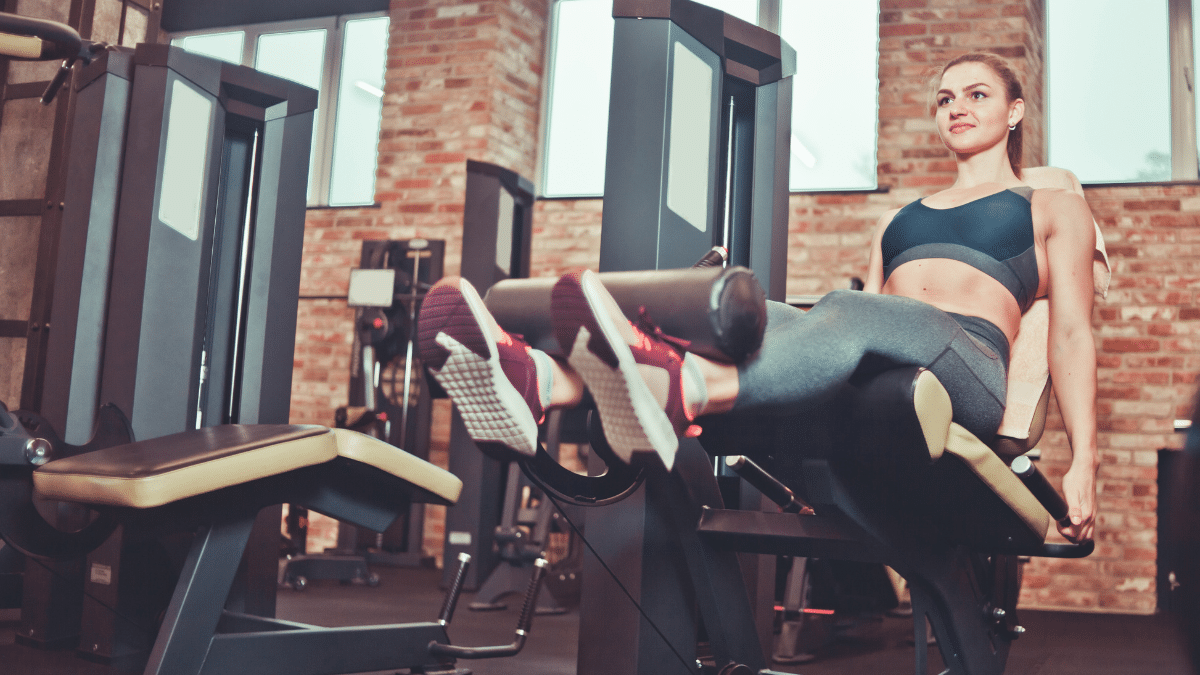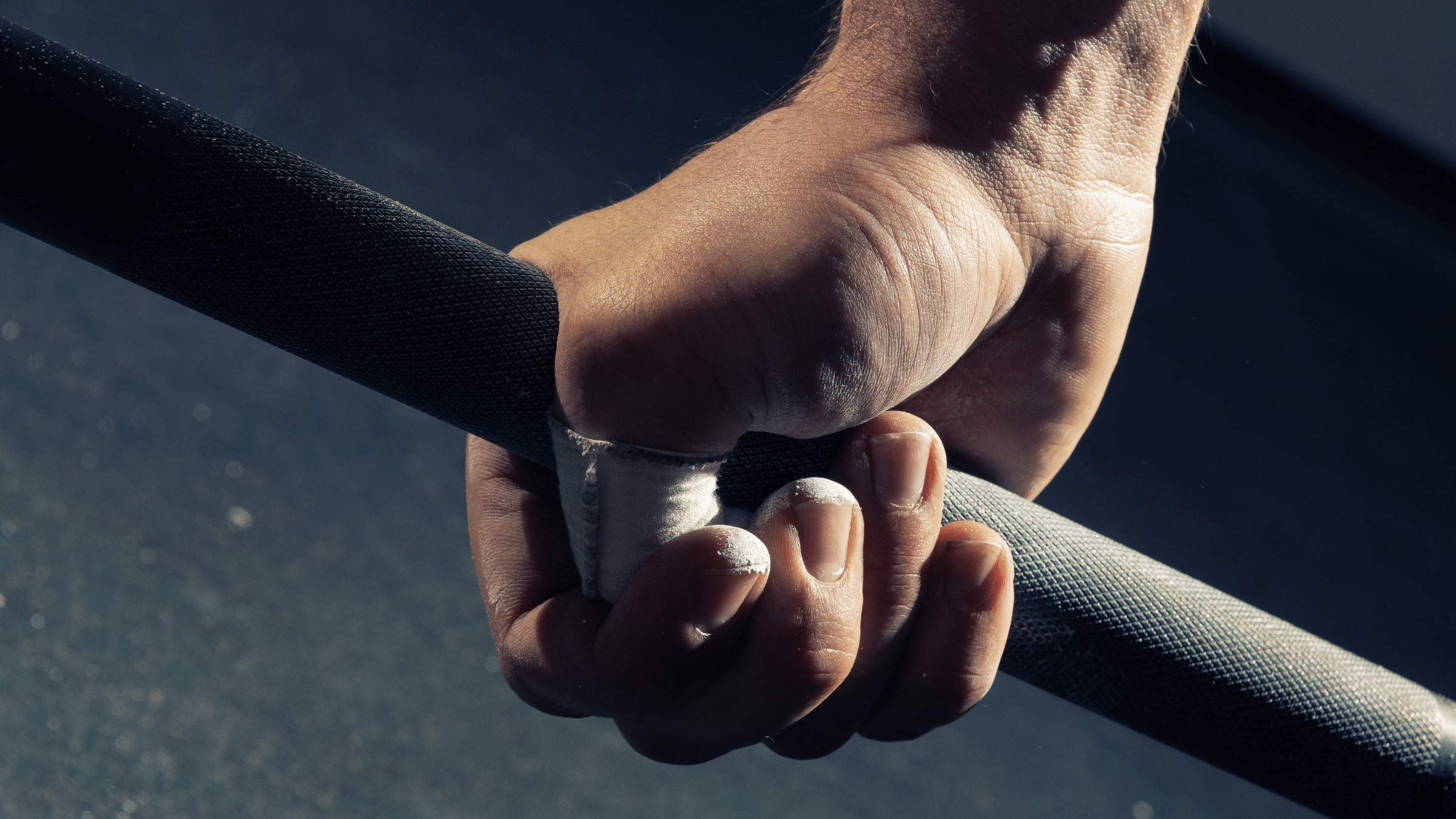A while back, I wrote an article titled Genetics and Strength Training: Just How Different Are We? Since that article was published, the question that’s come up the most often has been about non-responders. There can’t be people who simply don’t respond to exercise, right?
Back then, I made sure to point out that a “non-responder” in a scientific study simply didn’t respond to the training protocol used in the study, but that doesn’t necessarily mean they wouldn’t respond to any training program. Maybe the training protocol used in the study just wasn’t appropriate for them, or maybe they were participating in the study at a particularly bad point in their life for gaining muscle (high stress, poor sleep, not eating enough, etc.). I honestly hate the term “non-responder” – the only reason I use it is that it’s the terminology used in the literature.
However, since this question keeps coming up, I’ve been meaning to write an article to address the phenomenon of non-responders in a bit more detail.
This recently published study reminded me of the topic: Refuting the Myth of Non-Response to Exercise Training: ‘Non-Responders’ do Respond to Higher Dose of Training by Montero and Lundby (2017).
I’m not going to go into too much depth on this particular study because the details of it probably aren’t overly relevant to most of you, but briefly:
- A group of 78 people did endurance training for 6 weeks. They were split into 5 groups, training for an hour per session either 1, 2, 3, 4, or 5 days per week.
- After 6 weeks, if someone’s peak aerobic power didn’t increase, they were initially labeled a “non-responder.” 69% of the people training once per week were “non-responders,” 40% of the people training twice per week were “non-responders,” 29% of the people training three times per week were “non-responders,” and, tellingly, none of the people training four or five times per week were “non-responders.”
- The “non-responders” trained for another six weeks, doing two additional sessions per week. So the people initially training once per week started training three times per week, the people training twice per week started training four times per week, and the people training three times per week started training five times per week.
- After another six weeks of training, there were no non-responders. There was still a lot of variability in results – some people’s peak power increased a lot, and some people’s didn’t increase very much – but everyone’s fitness improved. To make sure they didn’t get any false positives, they ensured that everyone’s increase in peak power was at least 4% (i.e. the standard measurement error for peak aerobic power).
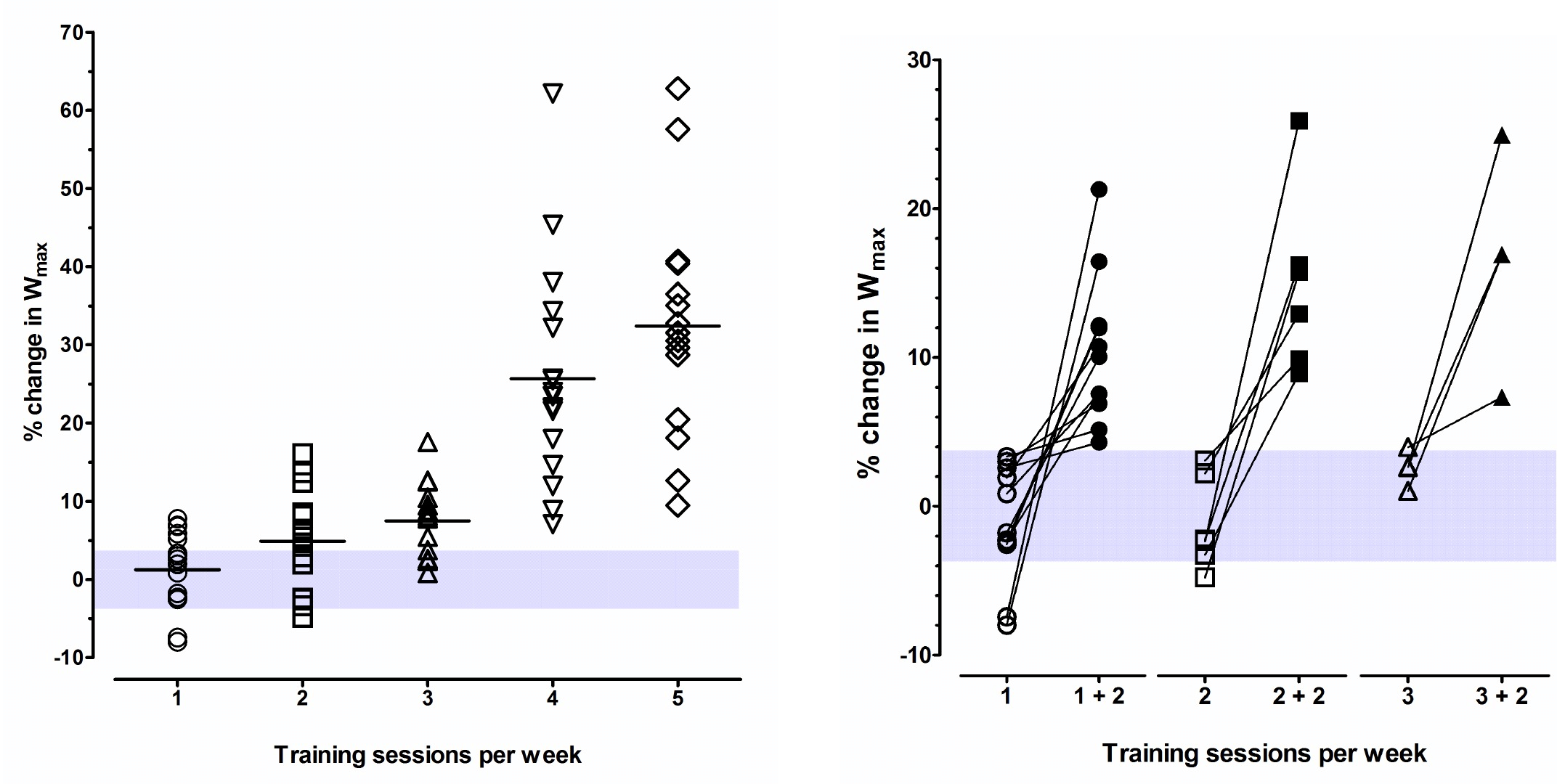
Now, I realize that most of you are primarily training to get strong and swole, so these results may not be that important to you, but they tie back into this article. If you’ll remember, it briefly touched on aerobic fitness. In a huge study with 481 participants, about 10 of them actually had small decreases in aerobic fitness, and quite a few more had essentially no change (within the range of standard measurement error).
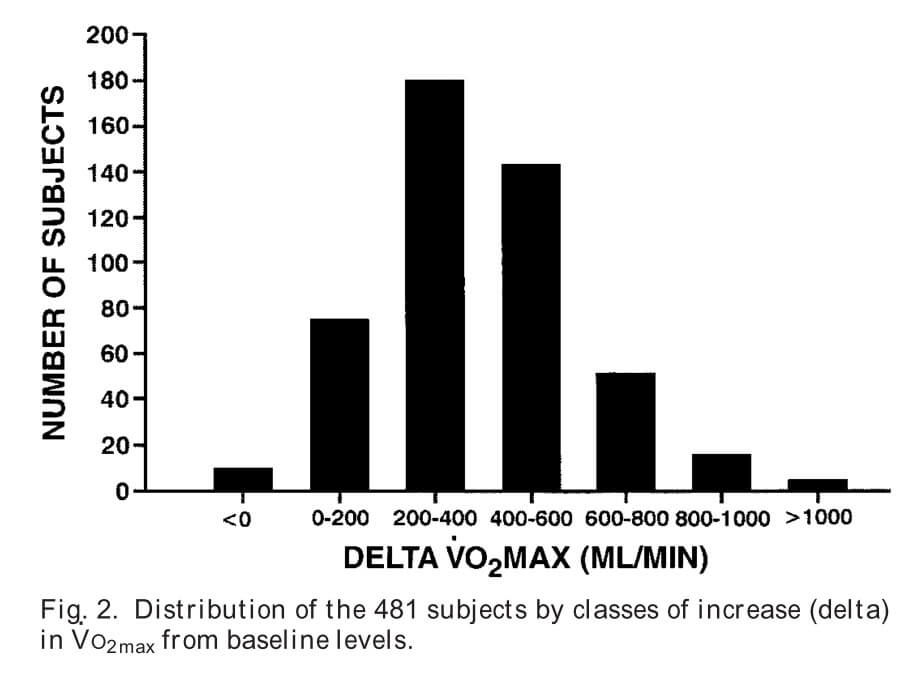
But now we see that if the people who weren’t responding just trained harder, there’s a pretty good likelihood that all of them would have made some progress. There may still be one or two stragglers, but you’d expect the number of non-responders to drop near zero.
So, does the same concept apply to strength?
Maybe.
A 2015 study (with a slightly misleading title) helps shed some light on the issue: There Are No Nonresponders to Resistance-Type Training in Older Men and Women by Churchward-Venne et al.
This study measured changes in lean body mass, muscle fiber size, strength (leg press and knee extension), and physical function (chair rise time). They found that all 110 participants made gains in at least one of those measures.
The reason I say the title is a bit misleading is that most people are worried about non-response for a particular adaptation (i.e. strength or, especially, hypertrophy). Obviously, when you exercise, something is going to happen, but people are concerned that they won’t experience a particular type of adaptation. This study essentially showed that when you train, at least some positive adaptations always take place, but it didn’t show that all positive adaptations take place.
However, this study did show that there are no (or very, very few) people who don’t get either bigger or stronger in response to training. In fact, all but one person gained at least some strength. “Non-response” rate for strength is much lower than for hypertrophy in the first place, but this is impressive when you consider the population in the study. All participants were at least 65 years old; older people can absolutely respond well to strength training, but they generally don’t respond quite as well as young folks.
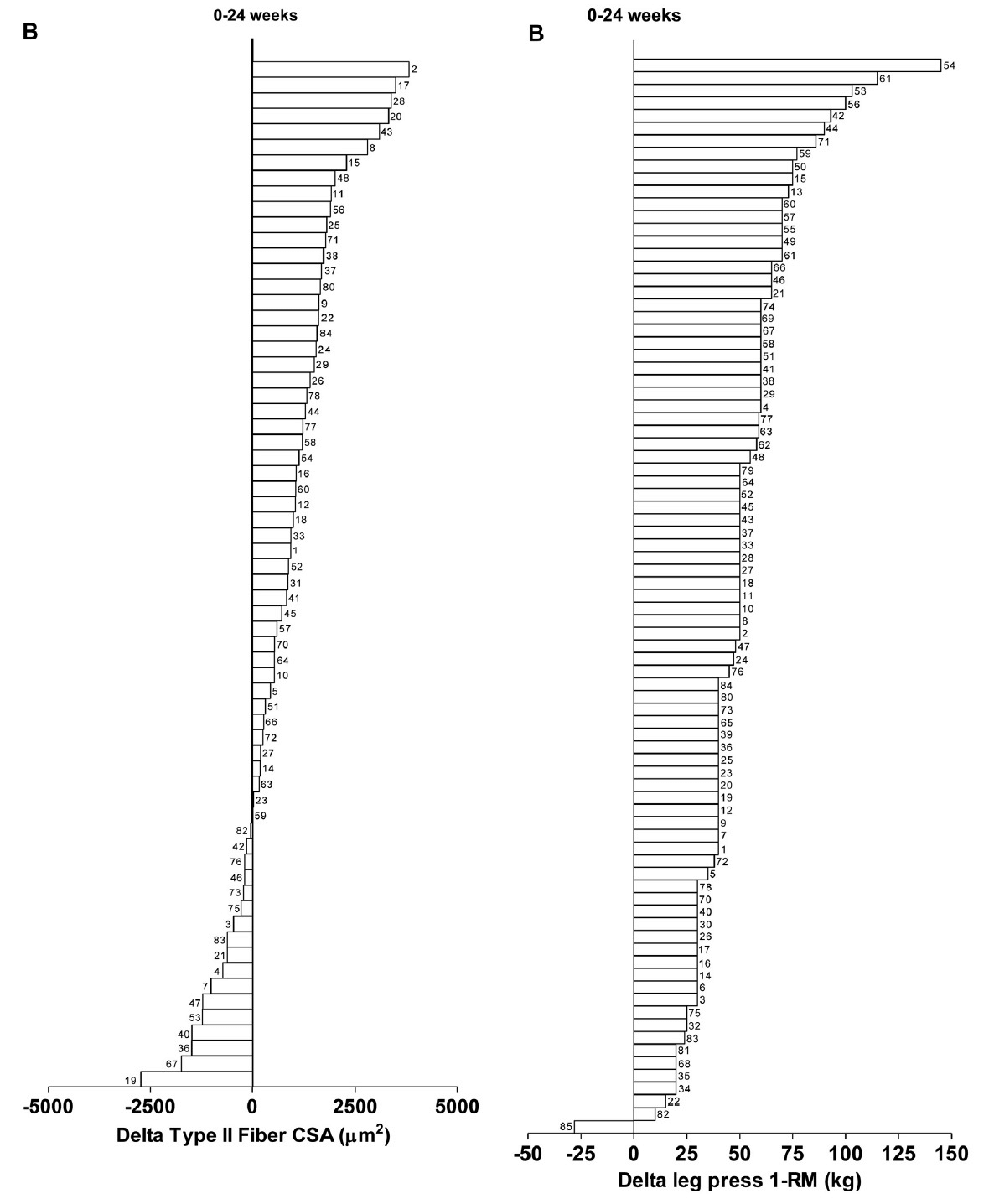
However, there were still quite a few people who didn’t gain any muscle, or, in fact, lost muscle. That may sound surprising, but it’s in line with a bunch of other research. So, what do we know about these people?
Not too much, unfortunately, but we have some hints.
One of these hints comes from data collected along with this study by Bamman et al. referenced in my last article on the subject.
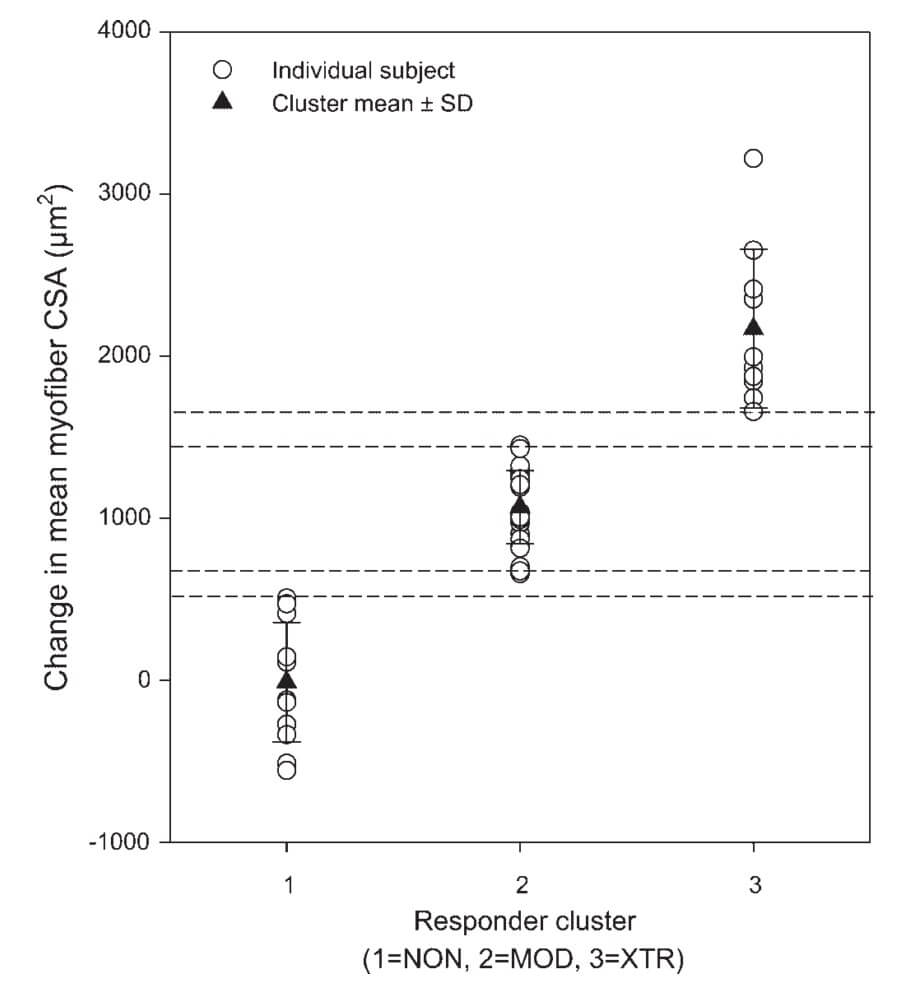
A few of the differences between the non-responders and the high responders aren’t too surprising: the expression of genes that code from growth factors associated with hypertrophy increased more post-exercise in the high responders, and high responders had an easier time adding more myonuclei to their muscle fibers. However, another key difference is the overall “signature” of the cellular signaling response.
In the high responders, the subsequent cellular responses “looked” like a growth response. In the non-responders, on the other hand, it looked much more like a magnified inflammatory response. Pro-inflammatory signaling increases post-training in everyone, of course, but not nearly to the degree seen in the non-responders in this study.
We get another hint from a study looking at the molecular networks activated in high and low responders. Interestingly, the high responders actually had blunted mTOR activation signature compared to the lower responders, which is surprising because the mTOR pathway is strongly implicated in initiating muscle protein synthesis. However, mTOR is also implicated in activation and regulation of the immune system – the people who responded worse may have had elevated activity in the mTOR pathway due to the excessive post-exercise inflammation alluded to earlier (post-workout inflammation and a localized immune response go hand-in-hand).
We also know that the initial (excessive) muscle damage people experience when they first start training likely inhibits hypertrophy – it’s all the muscles can do to just repair themselves, much less start growing. It takes a few weeks for a collection of adaptations to ramp up and partially protect the muscles from damage (this is known as the repeated bout effect), after which point the muscles start growing pretty rapidly.
Taken together, it looked like hypertrophic non-responders – people whose muscles either don’t grow or grow very little in response to resistance training – may be experiencing a hiccup in that protective system, so they wind up with excessive muscle damage and inflammation that prevent their muscles from growing.
This tentative explanation would make sense in light of the training protocol used in the Bamman paper: it involved 3 sets a piece of squats, leg press, and knee extensions, three times per week, with all sets taken to failure. That’s 27 hard sets, which is probably overboard for a fair amount of new lifters. It’s even more volume than the recent German Volume Training study where guys with some degree of training experience failed to grow on the notoriously high-volume program, likely because training volume was too high even for them.
As opposed to the cardio study I presented in the outset of this article in which people failed to improve because they weren’t training enough, it’s more plausible that a lot of the hypertrophic non-responders in resistance training studies fail to make gains because they’re training too much, and their muscles take longer to start adapting and protecting themselves from the assault of resistance training.
Now, it is possible, of course, that a lot of non-responders really are just screwed, and that nothing will help them build muscle. After all, markers of metabolic health actually worsen in a non-negligible amount of people when they take up exercise (which, strangely, not many people talk about), so it’s clear that some people’s bodies just respond to training in very unexpected ways. However, I think it’s unlikely that the “true” hypertrophic non-response rate is nearly as high as most studies report. With that in mind, here are 4 simple strategies to try to get more out of your training if you’ve been disappointed by how much muscle you’ve been able to build:
- Take care of business outside the gym. Sleep more. Manage stress as well as you can (if there’s nothing you can do to decrease the stressors in your day-to-day life, I’d strongly recommend taking up meditation). Eat more calories and especially protein (up to around 1g/lb, or 2g/kg).
- Assuming you’ve already tried increasing training volume (which should be your first thought, since higher training volumes generally mean more muscle growth) instead try decreasing your training volume for a while to maybe ~4-5 sets per muscle per week. Since non-responders have a magnified inflammatory response to training (which may be one of the major factors inhibiting hypertrophy), decreasing the intensity of the stressor may put it back into a beneficial, hormetic range.
- Give it time. Post-training inflammation tends to decrease with continued training, and the muscles’ protective adaptations continue accruing over time. It may be that muscles of people who respond well to training go through the initial “shock” phase in 1-3 weeks, and then start growing, but that “non-responders’” muscles take a few months to get through that phase, but will eventually toughen up and start growing.
- Try something new. As mentioned in the last article, a couple of papers (one, two) show that certain styles of training produce great results for some people but not others. If your muscles haven’t grown from heavy sets of 5 with long rest periods, they may instead grow from lighter sets of 20 with short rest periods, or from explosive training with low reps and no grinders. An approach to training that produces great results for the majority of people may not be what your body responds to.
At the end of the day, it’s crystal clear that some people simply respond way better to training than others. It’s also clear that damn near everyone gets stronger when they start training. However, muscle growth is a bit trickier, and almost every study (especially large studies) has some non-responders. Unlike aerobic training, we don’t know yet if simple programming modifications can ensure that everyone improves, though my hunch is that “true” non-response rate (i.e. people who simply cannot gain muscle in response to any sort of training) is considerably lower than the ~10-20% often seen in research.
Addendum, June 2017:
A new study showed that there were way fewer nonresponders when people were put on personalized training programs instead of one-size-fits-all standardized programs. This study was primarily looking at aerobic fitness, but it also examined strength measures (bench press and leg press 5RM). It found that all the subjects on personalized programs got stronger, while only 64.3% of the subjects on standardized programs got stronger. This gives us more evidence that “nonresponders” in scientific studies aren’t necessarily “true” nonresponders.
Read Next
- Genetics and Strength Training: Just How Different Are We?
- Your Drug-Free Muscle and Strength Potential, Part 1
- Your Drug-Free Muscle and Strength Potential, Part 2

